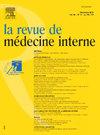La fibrillation atriale en 2025 : diagnostic et prise en charge
IF 0.9
4区 医学
Q3 MEDICINE, GENERAL & INTERNAL
引用次数: 0
Abstract
Atrial fibrillation (AF) is the most common arrhythmia. It increases the risk of hospitalization, heart failure, cognitive decline and mortality. It is the first cause of ischemic stroke. These are largely preventable if AF is diagnosed. It is essential to estimate the patient's embolic risk using the CHA2DS2-VA score, which now replaces the CHADS-Vasc score. Patients who require it must receive adequate anticoagulant treatment. New technologies (in particular, smart-watch) have led to advances in the detection and diagnosis of this arrhythmia. Patients suffering from AF may be treated with a heart rate control strategy (to limit tachycardia) or a rhythm control strategy (to maintain sinus rhythm). Catheter ablation is increasingly being offered to patients as an alternative to antiarrhythmic therapy. Controlling risk factors is essential to prevent the onset of AF, and to try to maintain sinus rhythm over the long term.
[2025年心房颤动:诊断与治疗]。
心房颤动(AF)是最常见的心律失常。它增加了住院、心力衰竭、认知能力下降和死亡率的风险。它是缺血性中风的首要原因。如果房颤得到诊断,这些基本上是可以预防的。使用CHA2DS2-VA评分来评估患者的栓塞风险至关重要,该评分现在取代了CHADS-Vasc评分。需要抗凝治疗的患者必须接受充分的抗凝治疗。新技术(特别是智能手表)在检测和诊断这种心律失常方面取得了进展。房颤患者可采用心率控制策略(以限制心动过速)或节律控制策略(以维持窦性心律)治疗。导管消融越来越多地被提供给患者作为抗心律失常治疗的替代方案。控制危险因素对于预防房颤的发生和长期维持窦性心律至关重要。
本文章由计算机程序翻译,如有差异,请以英文原文为准。
求助全文
约1分钟内获得全文
求助全文
来源期刊

Revue De Medecine Interne
医学-医学:内科
CiteScore
0.70
自引率
11.10%
发文量
526
审稿时长
37 days
期刊介绍:
Official journal of the SNFMI, La revue de medecine interne is indexed in the most prestigious databases. It is the most efficient French language journal available for internal medicine specialists who want to expand their knowledge and skills beyond their own discipline. It is also the main French language international medium for French research works. The journal publishes each month editorials, original articles, review articles, short communications, etc. These articles address the fundamental and innumerable facets of internal medicine, spanning all medical specialties. Manuscripts may be submitted in French or in English.
La revue de medecine interne also includes additional issues publishing the proceedings of the two annual French meetings of internal medicine (June and December), as well as thematic issues.
 求助内容:
求助内容: 应助结果提醒方式:
应助结果提醒方式:


